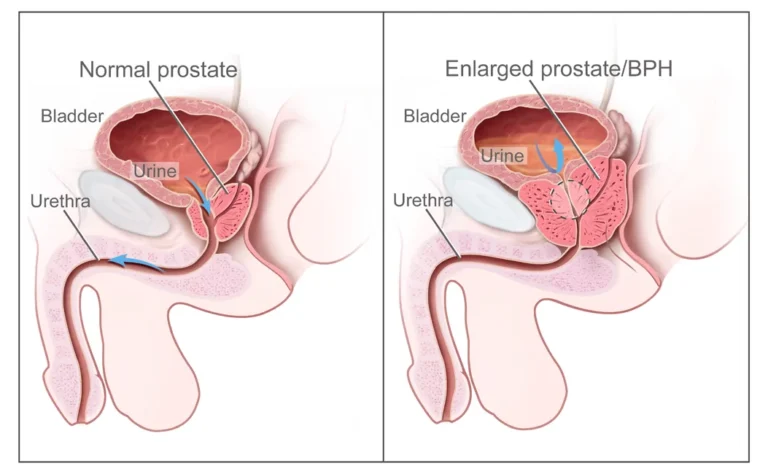Understanding Benign Prostatic Hypertrophy
Benign Prostatic Hypertrophy (BPH) refers to the non-cancerous enlargement of the prostate gland, a condition most common in aging men. While BPH can produce symptoms similar to prostate cancer, it is benign and does not increase one’s future risk of developing prostate cancer. According to the National Institute of Diabetes and Digestive and Kidney Diseases (NIDDK), BPH affects over half of men older than 60 and up to 90% of those over 70.
BPH develops when hormonal changes in aging men—particularly the decline in active testosterone and relative increase in estrogen—stimulate the growth of prostate cells. The prostate then enlarges, compressing the urethra and disrupting normal urinary flow. For more on maintaining hormonal balance as men age, see Testosterone Replacement for Low Libido.
Prostate Anatomy and Its Role in BPH
The prostate sits below the bladder and in front of the rectum, encircling the urethra—the tube that carries urine out of the body. Its main role is producing semen, which mixes with sperm during ejaculation. When the prostate enlarges due to BPH, this positioning means even a small increase in size can cause noticeable urinary symptoms, as the swollen tissue narrows or partially obstructs the urethra.
Common Symptoms and Warning Signs
BPH symptoms vary from mild to severe and typically include:
- Difficulty starting urination
- Weak or interrupted urine stream
- Frequent urination, especially at night (nocturia)
- Urgency or inability to delay urination
- A sensation of incomplete bladder emptying
- Pain or burning during urination
If the bladder fails to empty completely, urinary tract infections may develop. Some men also notice blood in their urine due to stretched or fragile blood vessels within the enlarged prostate. These concerns often prompt consultation with a doctor to exclude more serious issues such as prostate cancer or infection. You can learn about related urological symptoms in Urinating Blood After Sex.
Distinguishing BPH from Prostate Cancer
Although BPH and prostate cancer can produce similar urinary symptoms, BPH is entirely benign. Diagnosis often involves a PSA (prostate-specific antigen) blood test and a digital rectal exam (DRE) to rule out malignancy. For men already dealing with prostate health concerns, early evaluation is vital to ensure peace of mind and proper treatment.
Mild cases may resolve without intervention, but when symptoms interfere with quality of life, medications like alpha-blockers or 5-alpha-reductase inhibitors can help. Surgery, including procedures that remove or reduce prostate tissue, may be reserved for more severe cases. Complementary strategies such as maintaining a healthy weight, exercising regularly, and following a diet that supports prostate function (see Foods for Prostate Health) can also promote urinary and reproductive wellness.
Managing BPH and Maintaining Prostate Health
Although aging is an unavoidable factor, men can take proactive steps to protect their prostate health. Staying hydrated, limiting caffeine and alcohol intake, and engaging in regular exercise help reduce urinary strain. Awareness of changes in urination or sexual function can encourage earlier medical consultation, improving long-term outcomes and reducing anxiety.
For advanced or recurring prostate issues, consider exploring Fighting More Advanced Prostate Problems to understand current therapeutic options and lifestyle support available to men managing complex prostate conditions.


